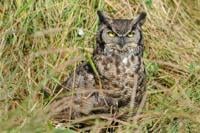BERLIN, Md. - A good Samaritan found herself in a close and painful encounter with an understandably unappreciative Great Horned Owl Tuesday after attempting to help the bird of prey.
According to the Assateague National Seashore Park Service, an unnamed couple was traveling near the intersection of Route 50 and 113 in Berlin Tuesday morning when they noticed the owl on the side of the road. The bird reportedly appeared injured, and it was assumed it had been hit by a car.
The couple stopped and placed the injured bird in their vehicle and took it to the Assateague National Seashore, presumably under the assumption the Park Rangers there could assist. Once they arrived, the woman attempted to pick the owl up again. This time, though, the owl was apparently lying on its back with its legs raised.
As the woman reached down, the owl apparently latched its talons into her arms. Great Horned Owls, according to the Audubon Center for Birds of Prey, can have a grip strength of over 500 psi with talons up to three inches long. The Park Service says the owl then refused to let go of the woman.
An ambulance and local biologists were called to assist in removing the bird. Before they arrived however, a park ranger on the scene found nearby fabric and covered the bird to calm it. This tactic reportedly worked, and the owl eased its grip on the woman, allowing her to escape.
The Park Service said the woman was treated at the scene for her injuries but refused to be transported to the hospital. Her identity and the extent of her injuries are unknown at this time.
The owl was taken to Tri-State Bird Rescue in Newark, Delaware, where it was examined by a wildlife veterinarian and rehabilitation manager. The examination revealed multiple grave injuries, including internal bleeding, fractures, and head trauma. Because of the severity of the injuries, the owl was humanely euthanized.
"Vehicle collisions often cause catastrophic injury," Lisa Smith, Executive Director of the Rescue, said in a statement. "In 2022, we received 56 owls that had been struck by vehicles. We were able to return 17 of them to the wild. The rest died or were euthanized due to the extent of their injuries."
The Rescue did note that the owl had a brood patch, indicating it likely had young. Great Horned Owls are early nesters, according to Smith, so it's probable the owl's young are already out of the nest. The hope is that the remaining parent will be able to care for them.
"We appreciate the efforts of the finder, the staff at Assateague State Park, and our dedicated transport volunteers to get this owl to us," Smith said. "While this bird’s injuries could not be treated, we were able to relieve it of its pain and suffering."
It is an unfortunate end, but the owl undoubtedly left a lasting impression on at least one person before passing.
Editor's Note: This story has been updated to reflect the humane euthanasia of the owl.


